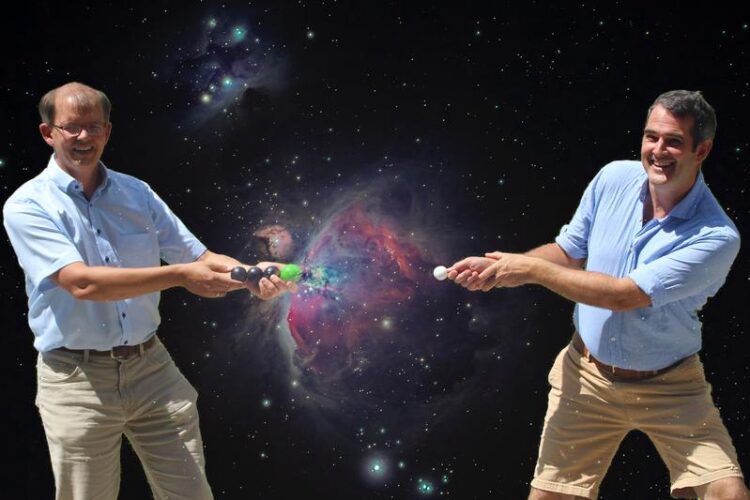Capturing Electrons in Space

Physicists Roland Wester (left) and Malcolm Simpson (right) demonstrate how dipole-bound states allow negative ions to form in interstellar clouds.
Bryan Goff on Unsplash / AG Wester
Linear molecules can capture and bind free electrons through the permanent dipole moment interaction. Physicists from the University of Innsbruck have achieved laboratory confirmation of the existence of dipole-bound states. Such states can form an intermediate step in the creation of negatively charged molecules and explain the existence of negative ions in interstellar clouds in space.
Interstellar clouds are the birthplaces of new stars, but they also play an important role in the origins of life in the Universe through regions of dust and gas in which chemical compounds form. The research group, molecular systems, led by ERC prize winner Roland Wester at the Institute for ion physics and applied physics at the University of Innsbruck, has set itself the task of better understanding the development of elementary molecules in space. “Put simply, our ion trap allows us to recreate the conditions in space in our laboratory,” explains Roland Wester. “This apparatus allows us to study the formation of chemical compounds in detail.” The scientists working with Roland Wester have now found an explanation for how negatively charged molecules form in space.
An idea built on theoretical foundations
Before the discovery of the first negatively charged carbon molecules in space in 2006, it was assumed that interstellar clouds only contained positively charged ions. Since then, it has been an open question how negatively charged ions are formed. The Italian theorist Franco A. Gianturco, who has been working as a scientist at the University of Innsbruck for eight years, developed a theoretical framework a few years ago that could provide a possible explanation. The existence of weakly bound states, so-called dipole-bound states, should enhance the attachment of free electrons to linear molecules. Such molecules have a permanent dipole moment which strengthens the interaction at a relatively great distance from the neutral nucleus and boosts the capture rate of free electrons.
Observing dipole-bound states in the laboratory
In their experiment, the Innsbruck physicists created molecules consisting of three carbon atoms and one nitrogen atom, ionized them, and bombarded them with laser light in the ion trap at extremely low temperatures. They continuously changed the frequency of the light until the energy was large enough to eject an electron from the molecule. Albert Einstein described this so-called photoelectric effect 100 years ago. An in-depth analysis of the measurement data by the early-stage researcher Malcolm Simpson from the doctoral training programme, atoms, light and molecules at the University of Innsbruck finally shed light on this difficult-to-observe phenomenon. A comparison of the data with a theoretical model finally provided clear evidence of the existence of dipole-bound states. “Our interpretation is that these dipole-bound states represent a kind of door opener for the binding of free electrons to molecules, thus contributing to the creation of negative ions in space,” says Roland Wester. “Without this intermediate step, it would be very unlikely that electrons would actually bind to the molecules.”
The work was supported by the Austrian Science Fund FWF, which also finances the PhD program Atoms, Light and Molecules (ALM) at the University of Innsbruck.
Wissenschaftliche Ansprechpartner:
Roland Wester
Department of Ion Physics and Applied Physics
University of Innsbruck
phone: +43 512 507-52620
email: roland.wester@uibk.ac.at
web: https://www.uibk.ac.at/ionen-angewandte-physik/
Originalpublikation:
Influence of a supercritical electric dipole moment on the photodetachment of C3N-. Malcolm Simpson, Markus Nötzold, Tim Michaelsen, Robert Wild, Franco A. Gianturco, and Roland Wester. Phys. Rev. Lett. 127, 043001 https://link.aps.org/doi/10.1103/PhysRevLett.127.043001
Media Contact
All latest news from the category: Physics and Astronomy
This area deals with the fundamental laws and building blocks of nature and how they interact, the properties and the behavior of matter, and research into space and time and their structures.
innovations-report provides in-depth reports and articles on subjects such as astrophysics, laser technologies, nuclear, quantum, particle and solid-state physics, nanotechnologies, planetary research and findings (Mars, Venus) and developments related to the Hubble Telescope.
Newest articles

Innovative 3D printed scaffolds offer new hope for bone healing
Researchers at the Institute for Bioengineering of Catalonia have developed novel 3D printed PLA-CaP scaffolds that promote blood vessel formation, ensuring better healing and regeneration of bone tissue. Bone is…

The surprising role of gut infection in Alzheimer’s disease
ASU- and Banner Alzheimer’s Institute-led study implicates link between a common virus and the disease, which travels from the gut to the brain and may be a target for antiviral…

Molecular gardening: New enzymes discovered for protein modification pruning
How deubiquitinases USP53 and USP54 cleave long polyubiquitin chains and how the former is linked to liver disease in children. Deubiquitinases (DUBs) are enzymes used by cells to trim protein…


